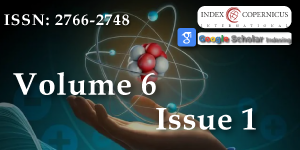Room temperature organic superconductor compound prediction based on fractals in mesoscopic-scale regime
Main Article Content
Abstract
Based on paraffin-wax include, volcano-based antimony-bearing, phospholipid, antimony found in gold deposit and TIPSb/triisopropylantimony ever predicted as the room temperature organic superconductor compound. Many flourishing explanations have been declared, from variational method to inductive deduction, with all indicating the presence of C9H21O3Sb.PBr6.
We consider that aplications in mesoscale regime, at least when using multiscale fractal of critical parameter that affects physical & chemical properties and to adopt “mesoscopic scale” ever stated as “superconductors” by Holmvall (2017). Then the mathematical induction of variational method of exploitation on integers & natural numbers herewith paraffin-wax etc can be resembled the ever built antimony containing compounds to keep the realm of predictions.
Article Details
Copyright (c) 2023 Hidajatullah-Maksoed W.

This work is licensed under a Creative Commons Attribution 4.0 International License.
The International Journal of Physics Research and Applications is committed in making it easier for people to share and build upon the work of others while maintaining consistency with the rules of copyright. In order to use the Open Access paradigm to the maximum extent in true terms as free of charge online access along with usage right, we grant usage rights through the use of specific Creative Commons license.
License: Copyright © 2017 - 2025 |  Open Access by International Journal of Physics Research and Applications is licensed under a Creative Commons Attribution 4.0 International License. Based on a work at Heighten Science Publications Inc.
Open Access by International Journal of Physics Research and Applications is licensed under a Creative Commons Attribution 4.0 International License. Based on a work at Heighten Science Publications Inc.
With this license, the authors are allowed that after publishing with the journal, they can share their research by posting a free draft copy of their article to any repository or website.
Compliance 'CC BY' license helps in:
| Permission to read and download | ✓ |
| Permission to display in a repository | ✓ |
| Permission to translate | ✓ |
| Commercial uses of manuscript | ✓ |
'CC' stands for Creative Commons license. 'BY' symbolizes that users have provided attribution to the creator that the published manuscripts can be used or shared. This license allows for redistribution, commercial and non-commercial, as long as it is passed along unchanged and in whole, with credit to the author.
Please take in notification that Creative Commons user licenses are non-revocable. We recommend authors to check if their funding body requires a specific license.
Bergstroem L. Mesocrystals in Biomineral & Colloidal Arrays. ACS. 2014.
Kumar SN. A Proper Approach on DNA-based Computer. ScIEP. 2015; 4.
Yoon T, Koo JY, Choi HC. High Yield Organic Superconductors via Solution-Phase Alkali Metal Doping at Room Temperature. Nano Lett. 2020 Jan 8;20(1):612-617. doi: 10.1021/acs.nanolett.9b04377. Epub 2019 Dec 17. PMID: 31825627.
Liu K. Multi-scale Fractal Analysis of Pores in Shale Rocks. J. of Appl. Geophysics. March 2017.
Denby L. Discovering the Importance of Mesoscale Cloud Organization through Unsupervized Classifications. Geophysical Research Letter. 5 Dec, 2019.
Holmvall P. Modelling Mesoscopic Unconventional Superconductors.thesis. 2017.
Capelli. Composite Fermion Wavefunctions Derived by Conformal Field Theory. June 30, 2012.
MinzFE. Mineralogical Characterisation of the Rockliden Antimony-bearing Volcanic-hosted Massive Sulphide Deposit, Sweden. Licentiate Thesis. Nov 2013.

